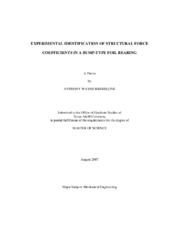| dc.description.abstract | This thesis presents further experimentation and modeling for bump-type gas foil
bearings used in oil-free turbomachinery. The effect of shaft temperature on the
measured structural force response of foil bearings is of importance for reliable high
temperature applications. During actual operation with shaft rotation, the bearing
structural parameters are coupled to the effects of a hydrodynamic gas film layer, thus
determining the overall bearing load performance.
A 38.17 mm inner diameter foil bearing, Generation II, is mounted on an affixed
non-rotating hollow shaft with an outer diameter of 38.125 mm. A cartridge heater
inserted into the shaft provides a controllable heat source. The clearance between the
shaft and the foil bearing increases with increasing shaft temperatures (up to 188°C). A
static load (ranging from 0 N to 133 N) is applied to the bearing housing, while
measuring the resulting bearing displacement, which represents the compliant structure
deflection. Static load versus displacement tests render the bearing static structural
stiffness. As the shaft temperature increases, the static test results indicate that the
bearing structural stiffness decreases by as much as 70% depending on the bearing
orientation. A dynamic load test setup includes a rigid shaft support structure and a
suspended electromagnetic shaker. Dynamic load (from 13 N to 31 N) test results show
that the test foil bearing stiffness increases by as much as 50% with amplitude of
dynamic load above a lightly loaded region, nearly doubles with frequency up to 200 Hz,
and decreases by a third as shaft temperature increases. A stick slip phenomenon increases the bearing stiffness at higher frequencies for all the amplitudes of dynamic
load tested. The test derived equivalent viscous damping is inversely proportional to
amplitude of dynamic load, excitation frequency, and shaft temperature. Further, the
estimated bearing dry friction coefficient decreases from 0.52 to 0.36 with amplitude of
dynamic load and stays nearly constant as shaft temperature increases.
Test results identify static and dynamic bearing parameters for increasing shaft
temperature. These experimental results provide a benchmark for predictions from
analytical models in current development and are essential to establish sound design
practices of the compliant bearing structure. | en |


